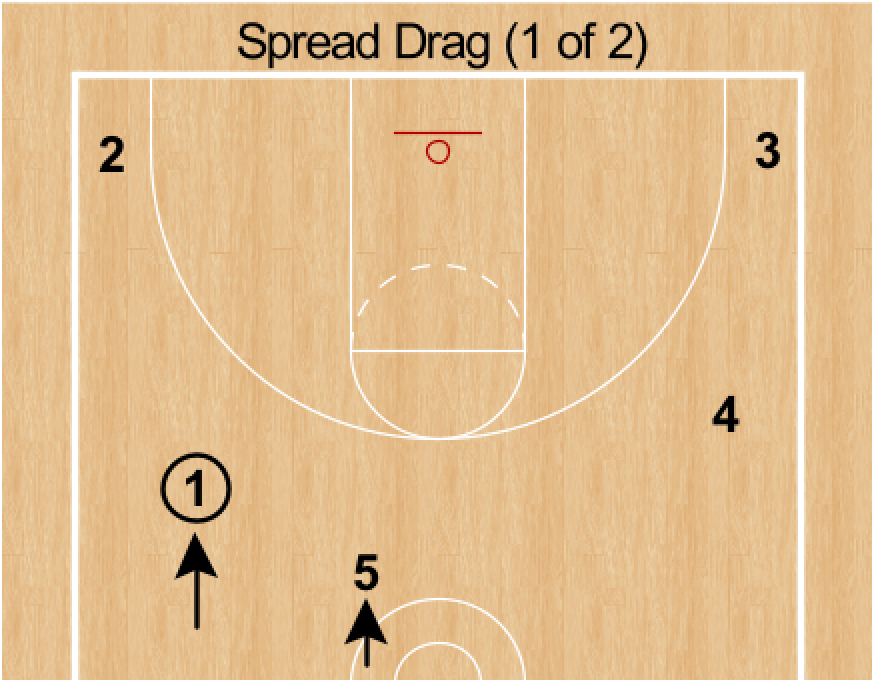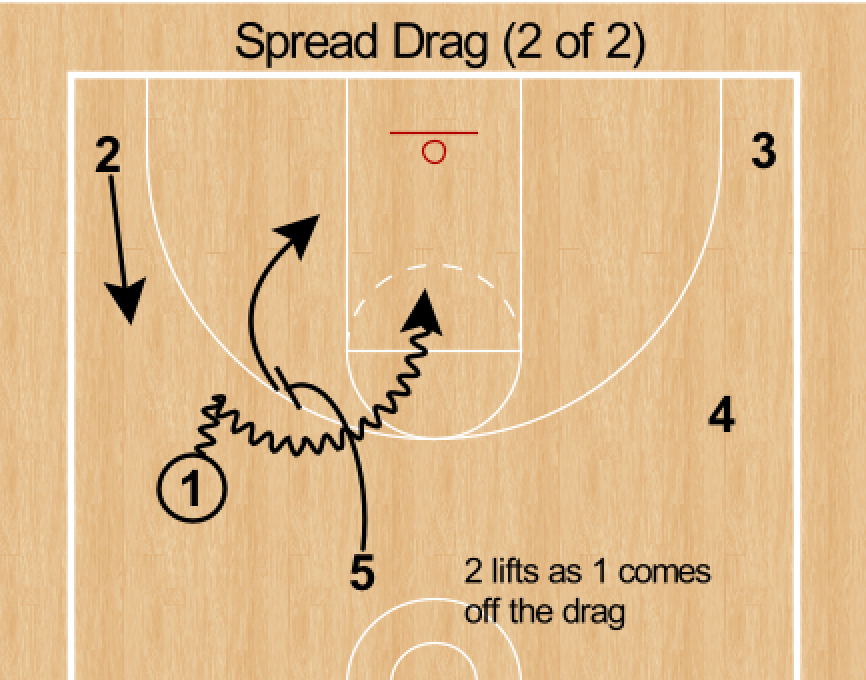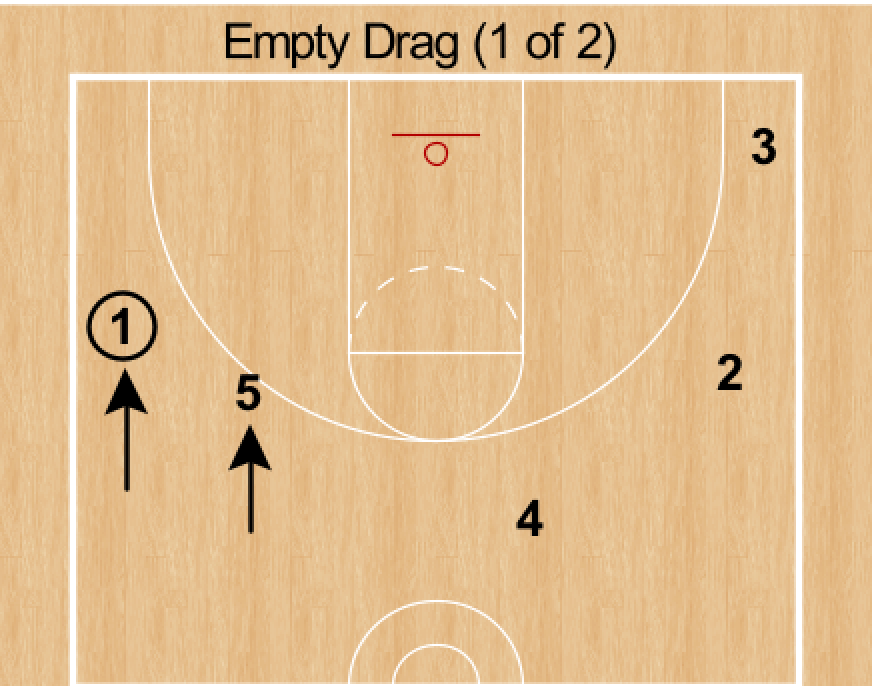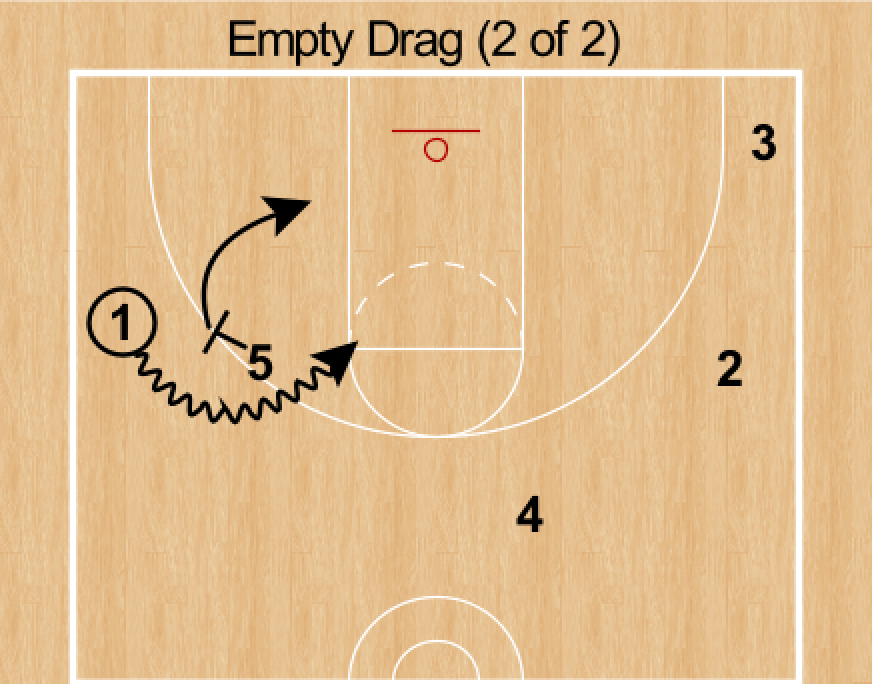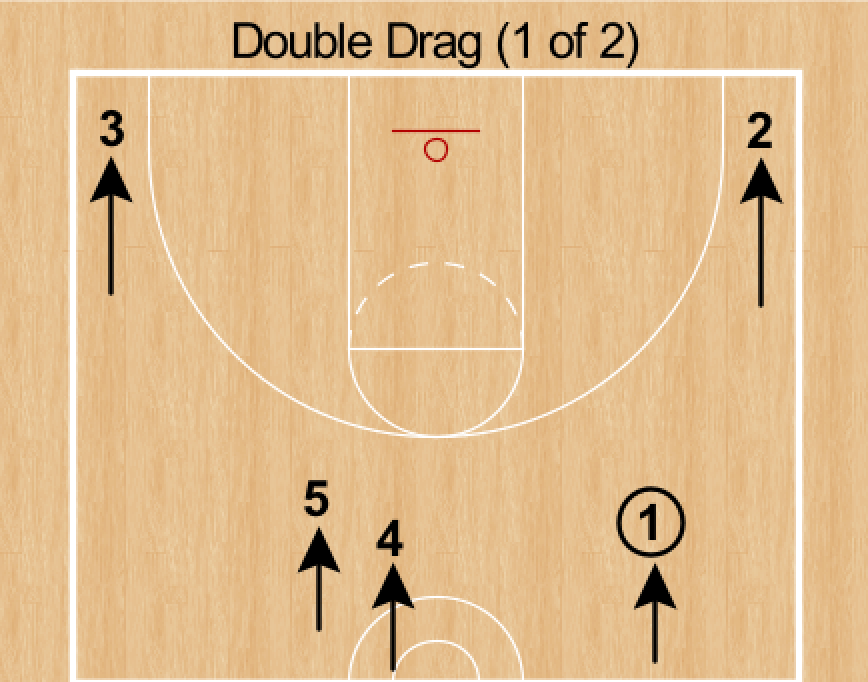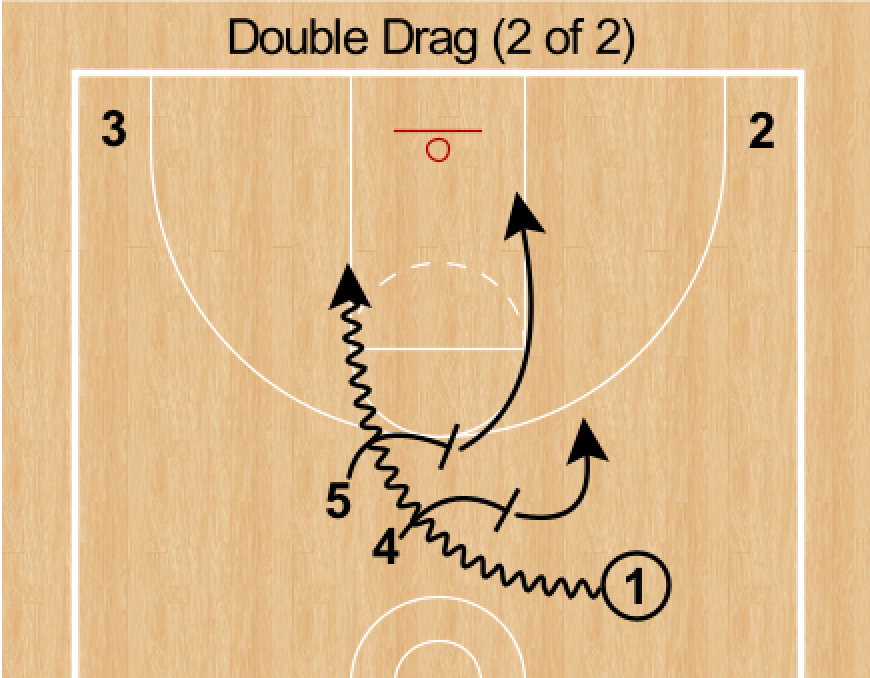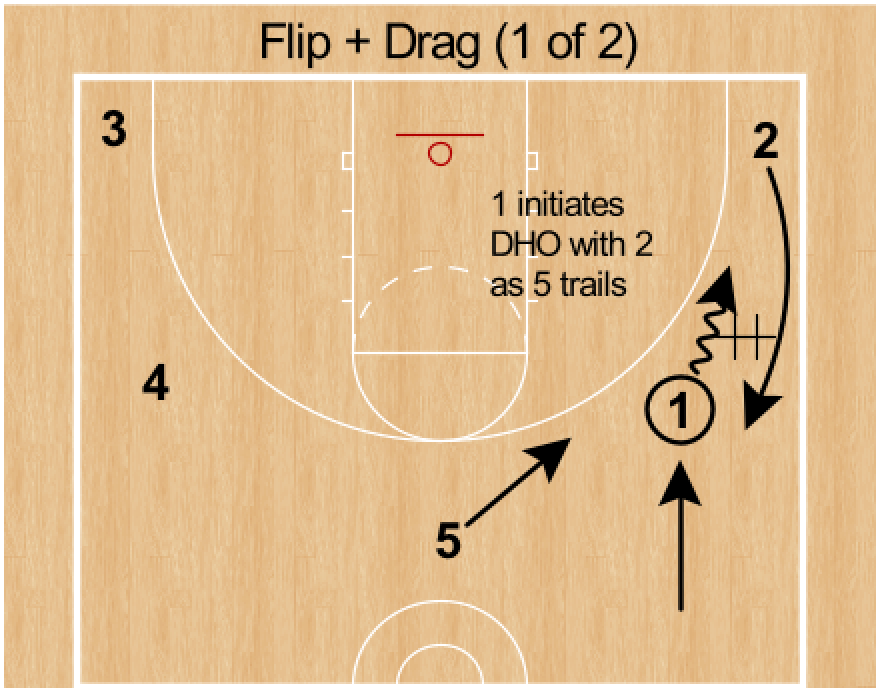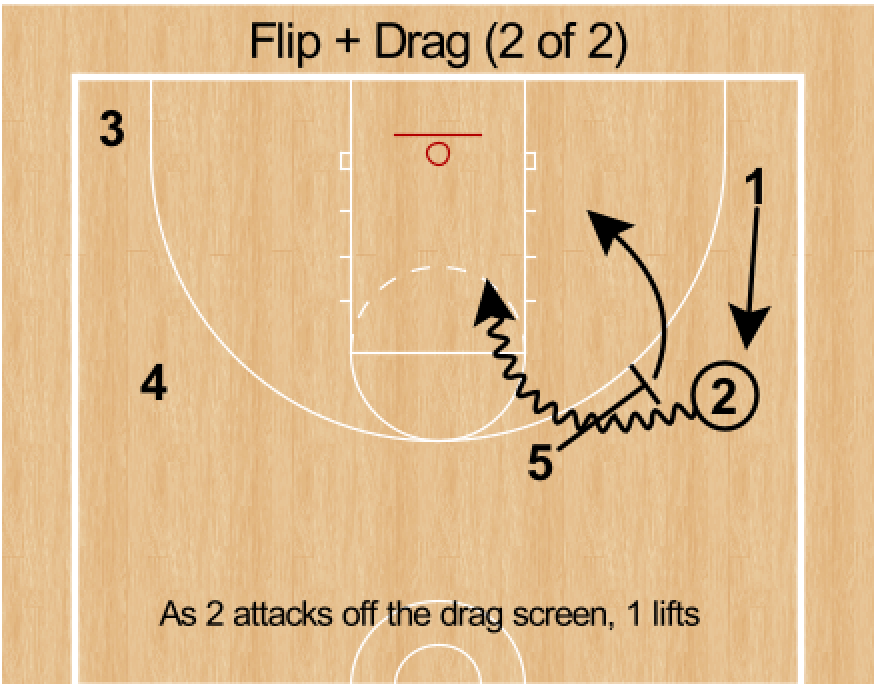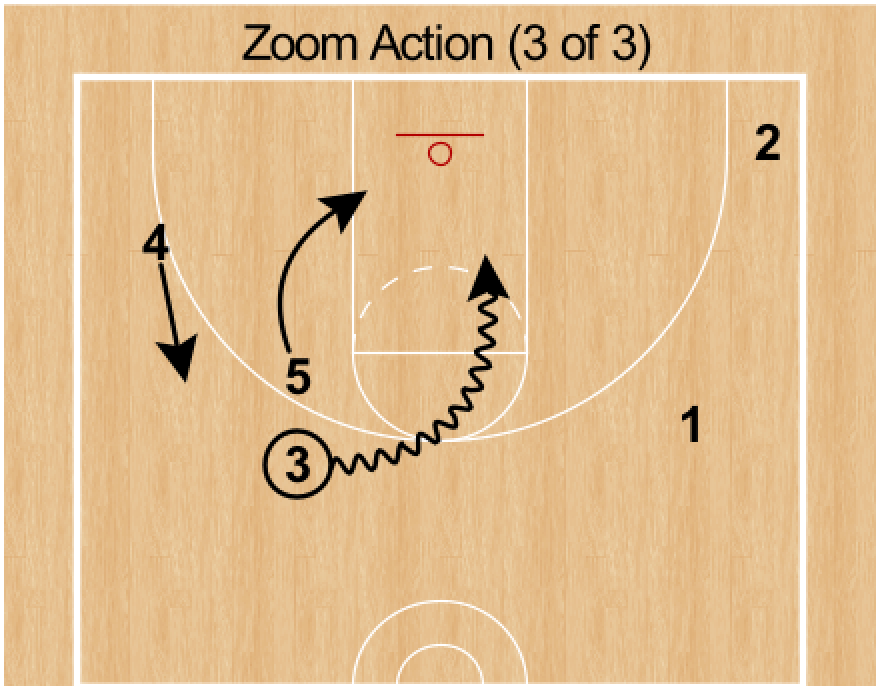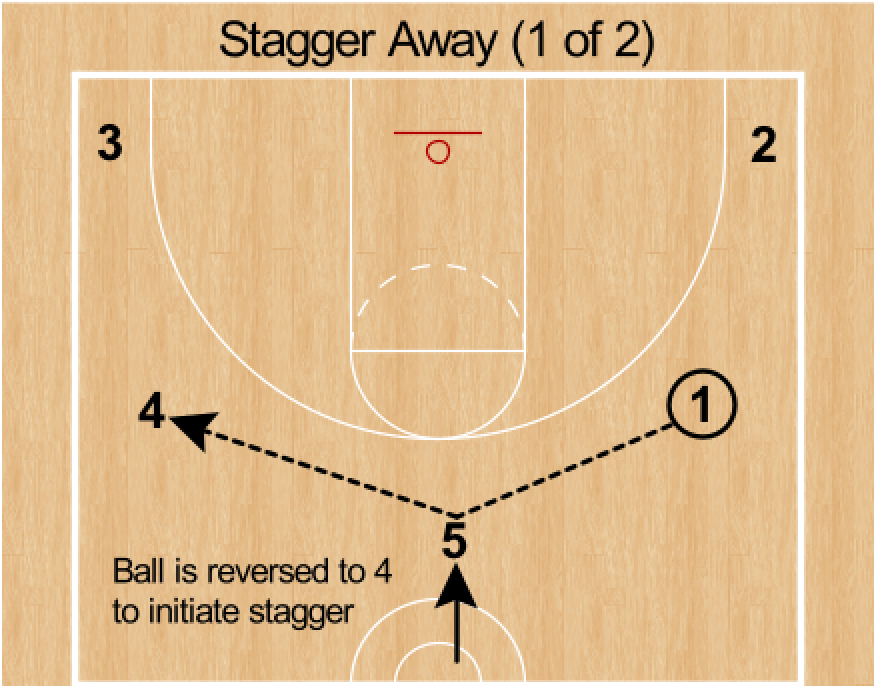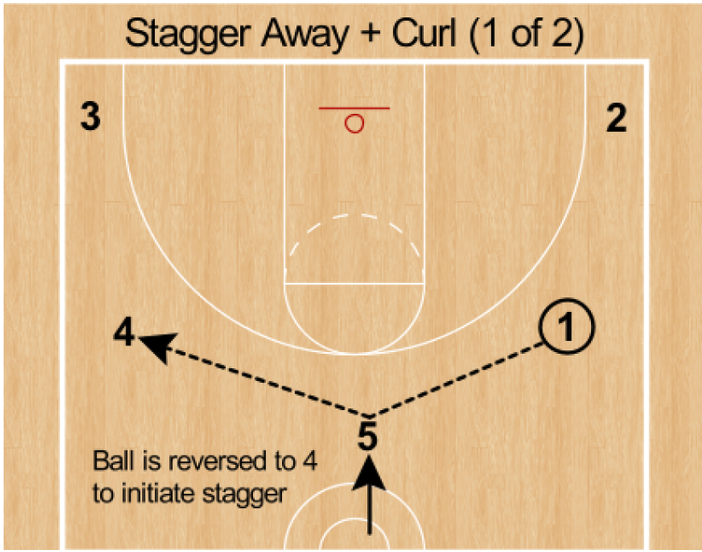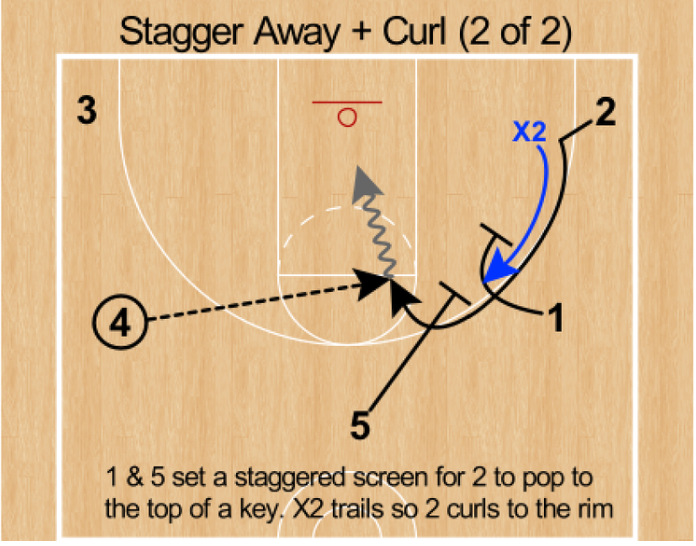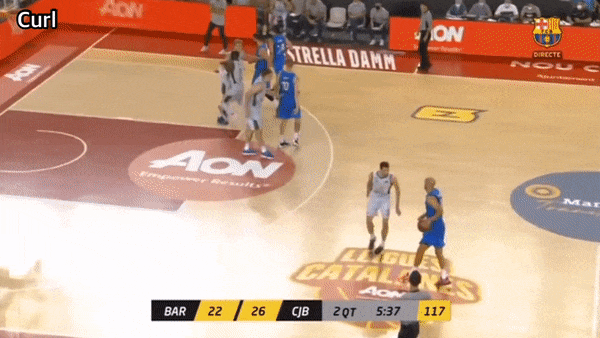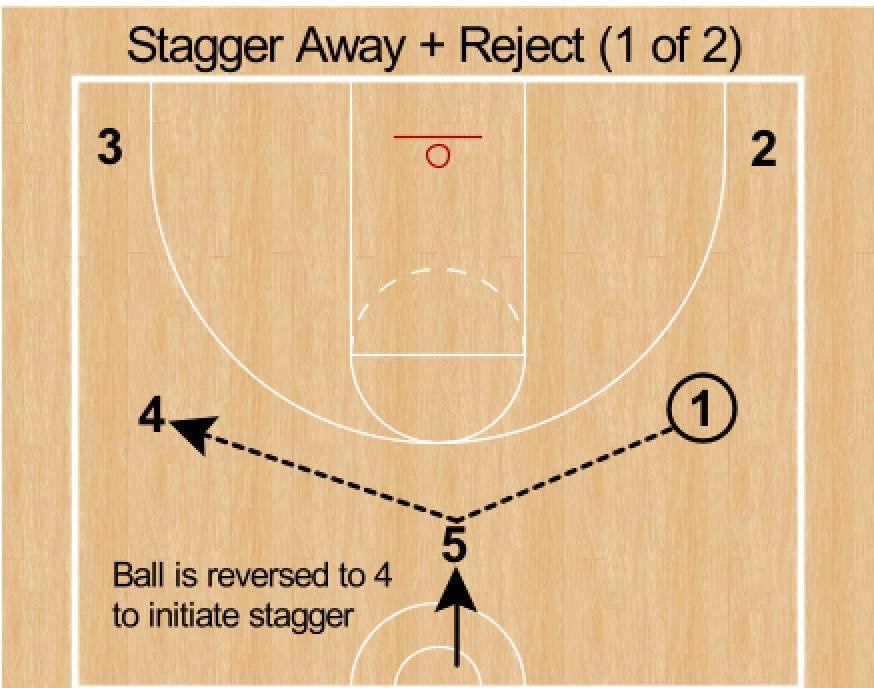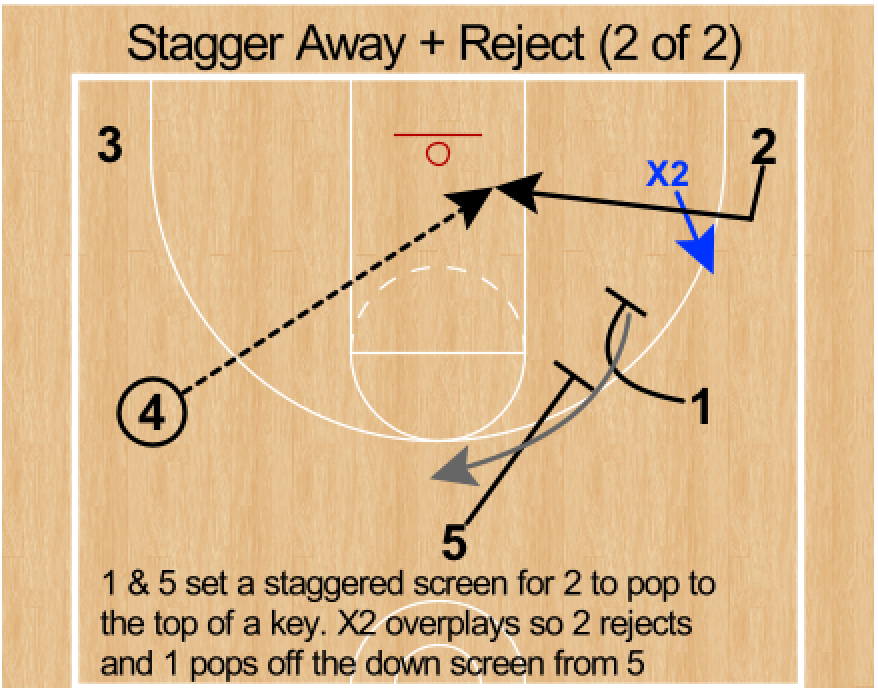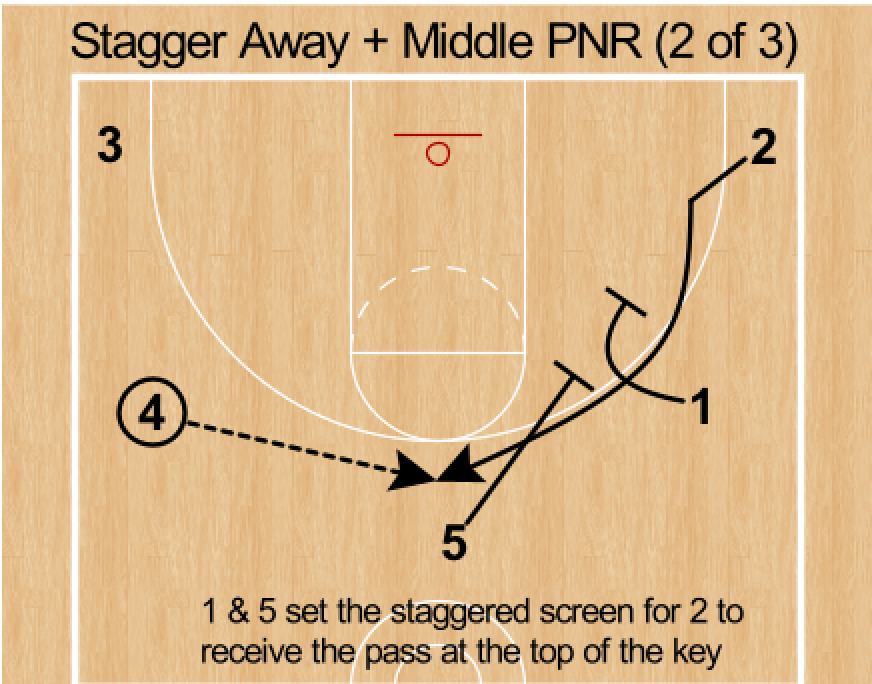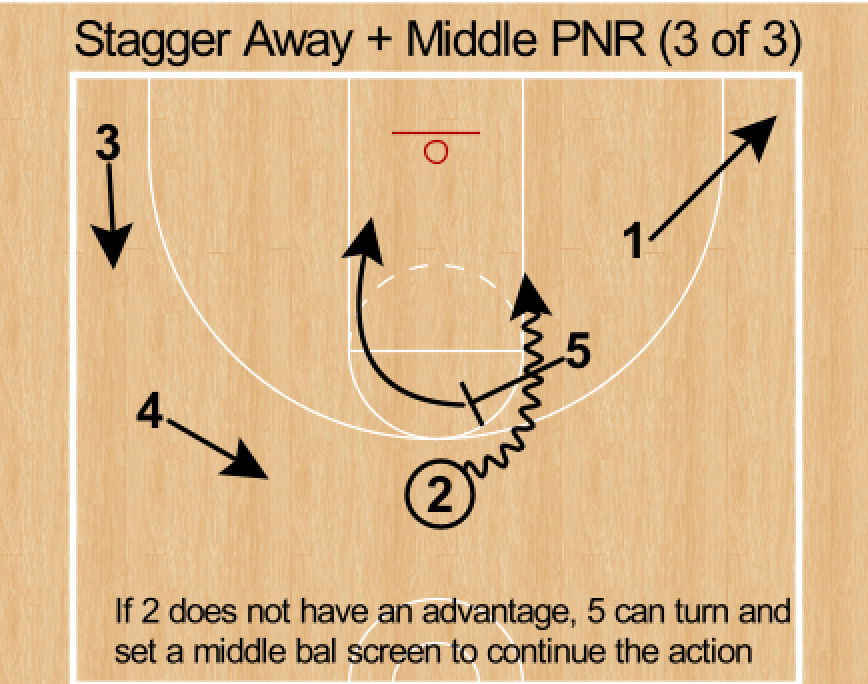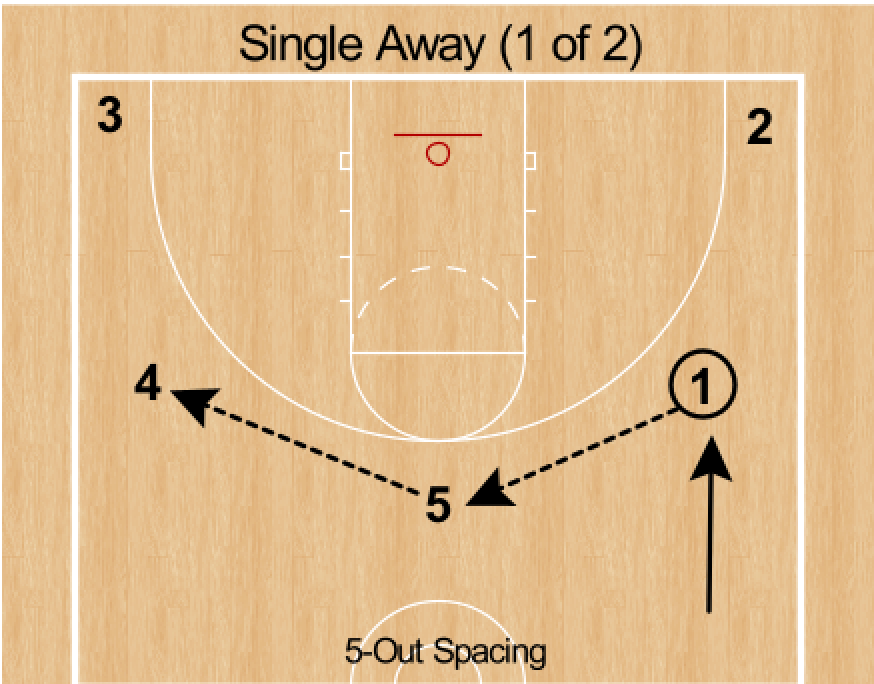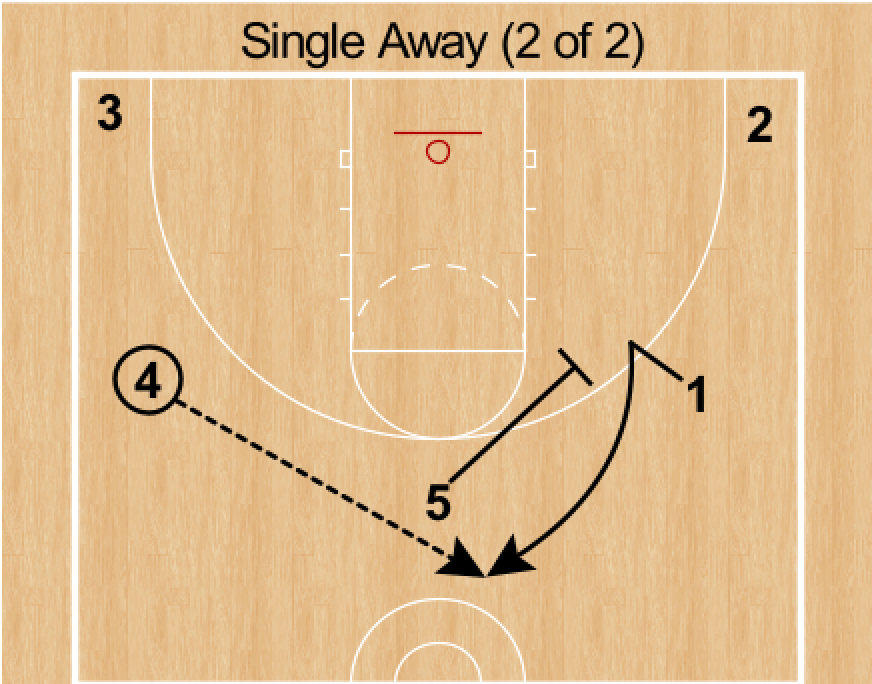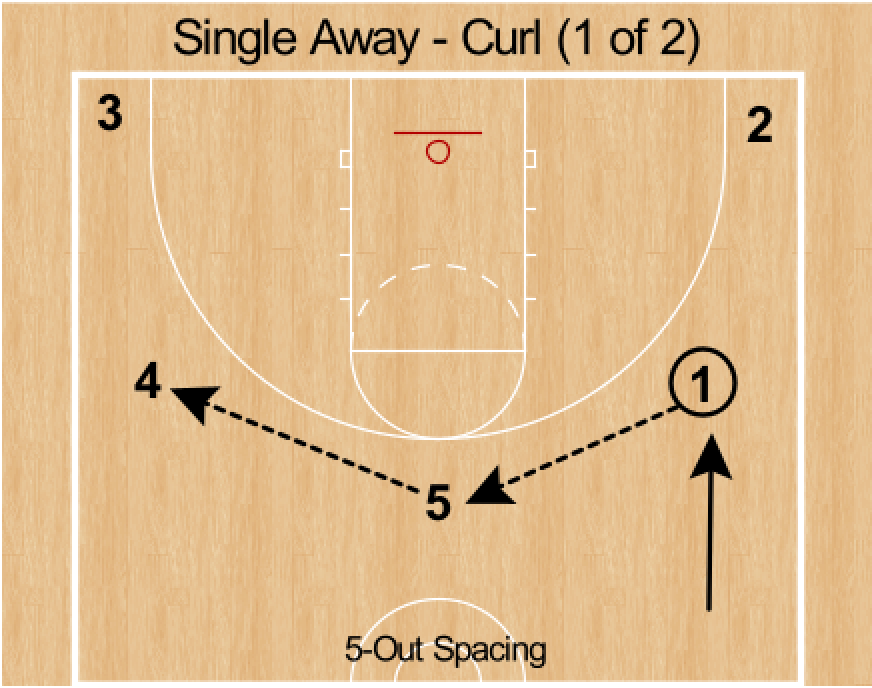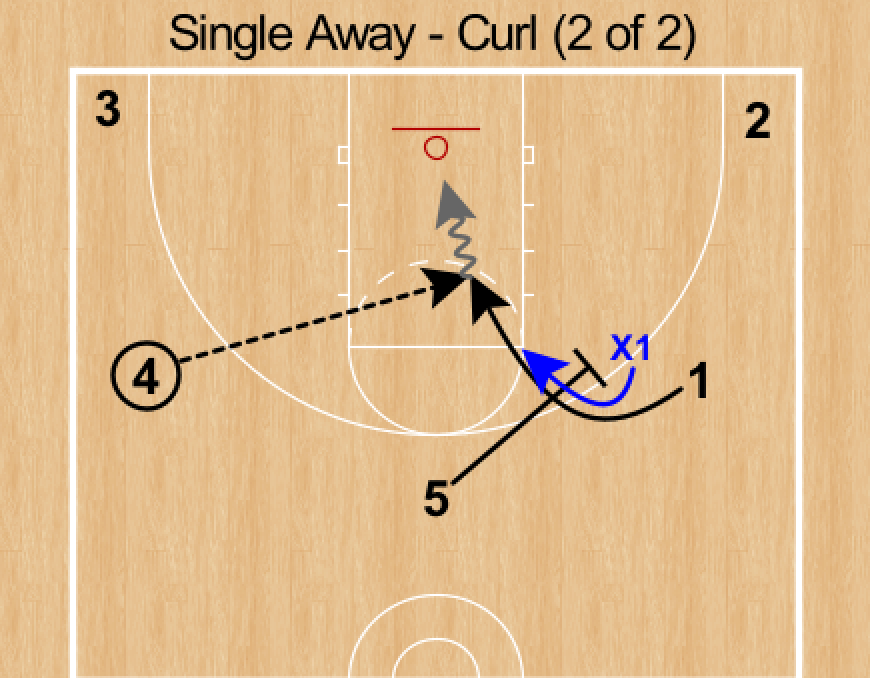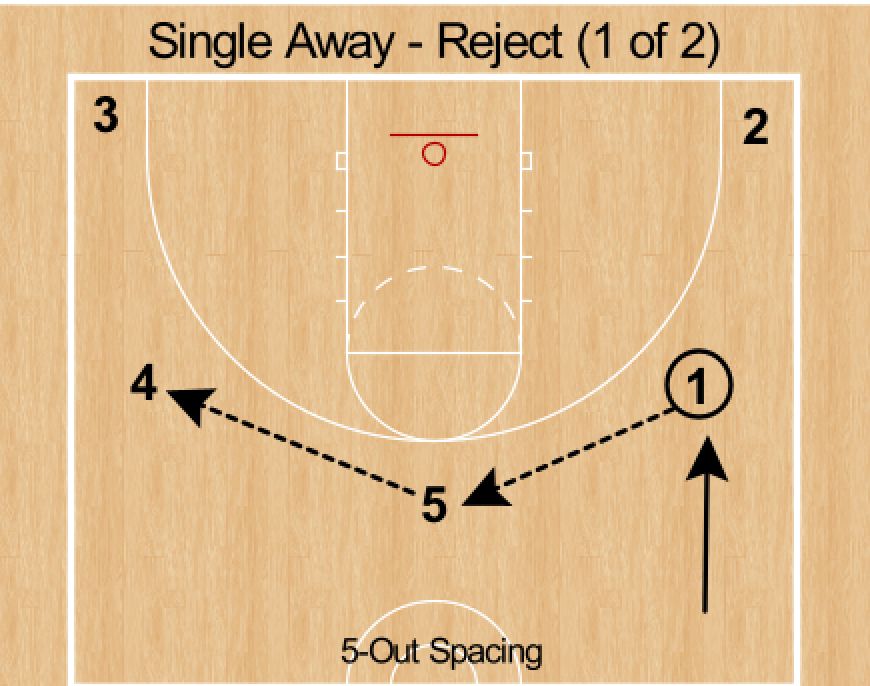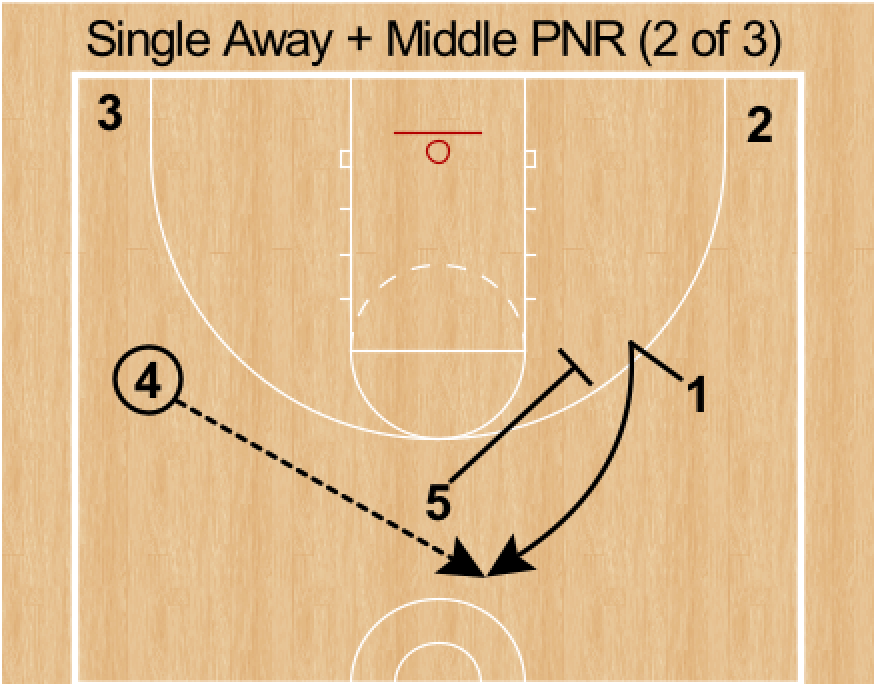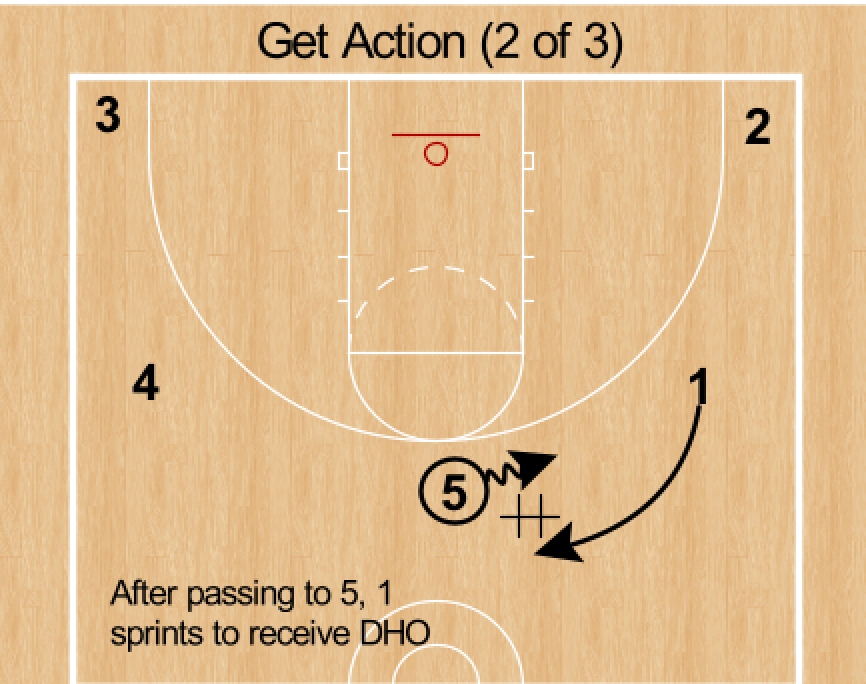5-Out Actions to Create Early Offense
The combination of wanting to play with more pace and space has led many teams to go 5-out on offense (5 players spaced along the perimeter) in recent years. Even teams that run strictly 4-out offense in the half court (i.e. Villanova) will run various 5-out actions if their post player is trailing the ball in transition.
With more and more teams trending towards 5-out, at least in transition, we are seeing more and more 5-out secondary breaks to create early offense. In this breakdown, we will look at how teams flow into their 5-out spacing in transition, as well as dive into some of the most popular 5-out actions to create early offense.
In This Breakdown:
➤ Zoom
Spacing in Transition:
To flow into 5-out spacing, most teams will sprint their wings to the deep corners in transition to pull the defense lower. After receiving the outlet the point guard will bring the ball up one side of the floor, while the 4 man fills the opposite side of the floor.
Typically, coaches will have their 5 man make a simple read. If you are ahead of the ball in transition, run to the rim. If you are behind the ball in transition (the 5 man rebounds or inbounds), trail down the center of the floor to the top of the key. The trailing 5 man creates the 5-out spacing.
In the example below, the 5 man is behind the ball so he trails to the top of the key to initiate a 5-out secondary action (some of which we will discuss later).
Drag Screen:
The “drag” screen is perhaps the most popular and widely used secondary break across all levels. It’s widespread use is a testament to its simplicity and effectiveness. Simply put, a drag screen is a ball screen set in transition by the trailing 5 man.
Ideally, the 5 man would look to set the drag screen just inside of the three point line. Setting the screen just inside the line allows the ball handler to pull up for three if the on-ball defender decides to go under the ball screen.
The 5 man also wants to set the drag screen at an angle that forces the on-ball defender to have to go over the top of the screen—forcing the defender over top of a ball screen creates an immediate numbers advantage for the offense.
Drag screens can be set at different locations with various spacing. In this breakdown, we will cover the two most popular types of drag screens—the spread drag and the “empty” drag.
Spread Drag
When we refer to a “spread drag” that is simply a drag screen set with spread ball screen spacing. The drag screen will be set in the slot, with a player located in the strong side corner, in addition to two players spaced along the weak side.
As the ball handler is attacking off the drag screen, the player (2) in the strong side corner “shakes” or lifts to the wing. By doing this, he forces his defender to make a decision—help on the screener rolling to the rim, or stay with the shooter lifting to the wing.
As the drag screen occurs, the players spaced on the weak side (3 & 4) have a few different options. They can hold the sideline to keep spaced, set a flare/pin down, 45 cut or exchange.
To learn more about weak side options to occupy help defenders during a ball screen, check out the Ball Screen Offense—Occupying the Help breakdown.
Empty Drag
An “empty drag” simply means the strong side corner is empty, meaning the three players not involved in the drag screen are spaced along the weak side. Ideally with an empty drag, you would like to set the ball screen at the wing.
Since the strong side corner is empty, the defender who would typically “tag” or help on the screener rolling to the rim is removed. This puts extra pressure on the two defenders guarding the drag screen action to be on the same page with their communication and coverage.
To dive deeper into drag screens, be sure to checkout the Keys to an Effective Drag Screen breakdown.
Double Drag:
Just like the name suggests, a “double drag" is when two players set drag screens for the ball handler in transition. Typically the double drag is set towards the middle of the floor, with the two players not involved in the double drag action spaced in each corner.
Most often the double drag screens are set by your 4 & 5 man, typically with the 4 setting the first screen. The player who sets the first screen in the double drag will pop to the perimeter, while the player setting the second screen (5) rolls to the rim.
Having your 5 man set the second screen and roll to the rim afterwards makes it difficult for a defense to switch this action. If they do switch, you could potentially punish them down low with a size mismatch or the ball handler (1) can attack the slower defender (X5) after the switch.
There are so many different options and scoring opportunities available within this simple action. For example, the Golden State Warriors will often flow into a double drag to mask their split action for an open catch & shoot three.
Flip + Drag:
“Flip + Drag” (also referred to as 21, pitch drag, etc.) is another popular 5-out drag screen action.
To flow into this action, the ball handler in transition (1) will initiate a dribble handoff with the strong side corner (2) as 5 trails to set the drag screen. The player in the corner (2) will sprint to receive the DHO from 1, before using the drag screen set by 5 and looking to turn the corner. As 2 is coming off the drag screen set by 5, 1 will “shake” or lift to get in 2’s vision for a possible kick back pass.
This is a great action to create early offense and put pressure on the defense by forcing them to guard consecutive actions (DHO + Drag Screen) immediately after sprinting back in transition.
Not too mention there are multiple scoring options—2 can come off the drag screen looking to score, he can hit 5 as he rolls to the rim, or he can kick the ball along the perimeter for a shot, drive or post entry.
“Zoom” Action:
“Zoom” is another popular 5-out actions teams will flow into as a secondary break to try and create early offense.
This action is initiated by the ball handler (1) centering the ball to the trailing 5 man in the center of the court. The 5 man then takes 1-2 dribbles along the three point arc either direction. This triggers a pin down from the strong side wing (4) for the strong side corner (3).
The player in the corner (3) will set his defender up before “zooming” off 4’s pin down screen to receive the dribble handoff from 5. The player receiving the DHO (3) wants to run through the handoff, looking to turn the corner and get downhill.
After handing the ball off, 5 will roll to the rim, while player who set the initial pin down (4) “shakes” or lifts for a possible kick back pass. Lifting also forces his defender to make a decision—help on 5 rolling to the rim, or stay with the shooter as he lifts to the wing.
“Zoom Action” puts an extreme amount of pressure on the defense, as they must guard consecutive actions along the perimeter. First, they must communicate and cover the pin down screen. Secondly, they must communicate and cover the dribble hand off.
Not too mention, the player running through the DHO to turn the corner along with the 5 man rolling hard to the rim puts pressure on the rim. This forces the defense to collapse, which can lead to open kick out threes.
Stagger Away:
If you have solid shooters on the floor, a staggered away screen is another great 5-out option to create a high percentage shot early in the possession.
The best part of this action is how simple it is to flow into. To initiate this action, the ball handler simply centers the ball to the trailing 5 man, who reverses to 4 on the opposite side of the floor. 1 & 5 would then set a staggered away screen for 2 to use and sprint to the top of the key for a shot.
Staggered screens are extremely difficult to defend—there are three defenders involved in guarding the action so they must communicate and be on the same page, which is easier said than done at game speed.
If 2’s defender trails him off the staggered screens, he can look to curl and receive the pass going towards the rim.
If 2’s defender overplays the stagger, he can reject the screens and back cut to the rim, at which point 1 could pop off the now single down screen by 5.
There are also many different options in terms of what you can flow into if there is no initial advantage from the staggered away screen. Most teams will have the 5 man turn and set a middle ball screen for the player who received the pass at the top of the key, but I have also seen teams flow into Point Series, Zoom Action, etc.
Single Away:
The “single away” action is similar to the stagger action in how it is triggered, but as you can guess it involves a player sprinting off a single away screen from 5, rather than a staggered screen.
To start, 1 centers the ball to the trailing 5 man, who swings the ball to 4 on the opposite side of the floor. After swinging the ball, 5 will then screen away for the player on the weak side wing (1). 1 will set his man up before using 5’s screen to pop to the top of the key for a potential shot or drive.
If 1’s defender (X1) trails 1 as he comes off 5’s away screen, 1 should look to curl around the screen and receive the pass going towards the rim.
If 1’s defender overplays or denies the away screen, 1 can reject and cut to the rim looking for a pass from 4. If 1 does reject the away screen but does not receive the pass on his cut to the rim, 5 can pop to the top of the key and receive the pass from 4 to flow into the next action like a “get” which is covered next.
If the two defenders involved in guarding the away screen action decide to switch, 5 can simply duck in and post up the smaller defender (X1).
Similar to the staggered action above, there are many different options in terms of what you can flow into if there is no initial advantage from the away screen. Most teams will have the 5 man turn and set a middle ball screen for the player who received the pass at the top of the key (1), but I have also seen teams flow into Point Series, Zoom Action, etc.
“Get” Action:
The final 5-out action to create early offense we will discuss in this breakdown is what is becoming commonly known as “get” action.
“Get” action is simply when the ball handler passes the ball to a player (usually a big) and then immediately sprints to receive a hand off from that same player who received the pass. From there, the reads for the two players involved in the action are the exact same as they would be with a ball screen.
If 1’s defender trails him over the top of the hand off, 1 can look to turn the corner and get downhill as the player who made the hand off (5) rolls to the rim. If 1’s defender goes underneath the hand off, 1 can look to shoot on the catch if he is a solid shooter. If not, 5 can turn after handing the ball off and “twist” or re-screen for 1 on the opposite side to force his defender over.
A “get” is a quick and efficient two-man action that can be easily triggered whenever the 5 man catches the ball above the free throw line.
For a more detailed dive into “get” action, checkout the breakdown, “Get” Action Explained.


